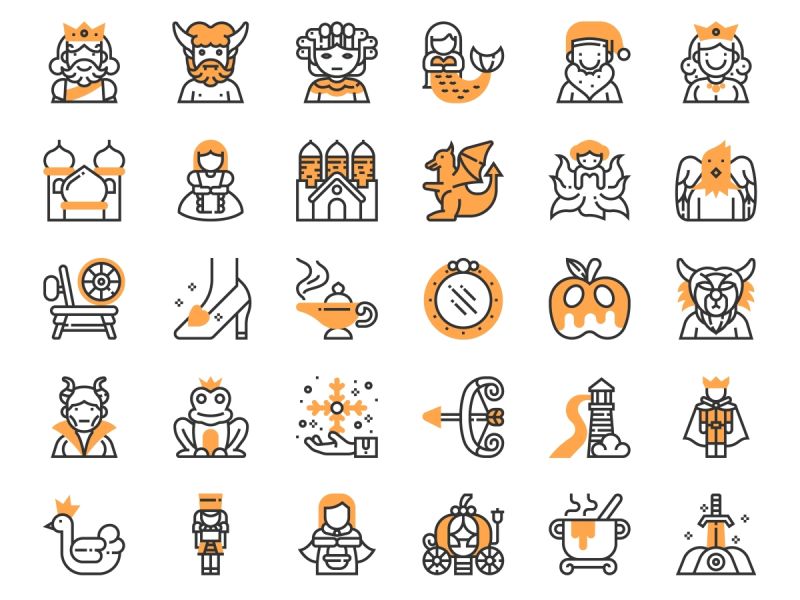Just for Fun: Live Happily Ever After With These Magical Fairy Tale Names (& Stikins®)

Today is the anniversary of the birth of Wilhelm Grimm (the younger of the two “Brothers Grimm”) and Sunday is Tell a Fairy Tale Day. So, we're celebrating the world of fairy tales. Plus, find out how Stikins® name labels help avoid the grim nightmare of lost property.
Fascinating Tales & Grimm-Inspired Names From Fairy Tales
Fairy tales are so old that no one knows their exact origins. They probably evolved from ancient stories from around the world. These were oral tales were passed on by being spoken aloud or performed. Some surviving examples are around 4-5,000 years old. Over time, they were written down. One of the oldest examples comes from Ancient Egypt around 1300BC. The oldest version of Cinderella was written in China in 860CE. For centuries, fairy tales have been updated to suit new audiences. Today, there are thousands of versions of the same tales.
Until the 19th century, fairy tales were for adult audiences. Most of today's fairy tales come from a handful of collections, including those by French author Charles Perrault and German writers Jacob and Wilhelm Grimm (the Brothers Grimm).
- Perrault’s collection, Tales and Stories of the Past, with Morals (or Mother Goose Tales), was published in 1697. It included versions of Little Red Riding Hood, Cinderella, Puss In Boots, Sleeping Beauty, and Bluebeard.
- The Brothers Grimm published Children’s and Household Tales in 1812. By 1857, there were seven editions with various revisions, additions, and subtractions. The first edition had two volumes of 86 and 70 tales; the final edition had 210 tales.
Both collections contained versions of existing folk tales. The Grimm collection even included versions of some of Perrault’s tales. Both collections shared a common source – women.
The Grimm Brothers invited people to tell them folk tales; most were middle-class or aristocratic female acquaintances. Perrault was probably influenced by 17th century women’s salons. Aristocratic (and educated) women met in their living rooms (salons) to talk about various topics. These salons often included a parlour game where each member retold an old folk tale.
The name “fairy tale” came from one of these salons where Marie-Catherine d’Aulnoy described her tales as “conte de fées”. The traditional opening, “once upon a time”, is much older. Used since at least 1380, it became part of fairy tales (and other stories) in the 17th century. Some folklorists prefer the German term Märchen or “wonder tale” to describe fairy tales. This accounts for fairy tales that aren't about fairies (but are about wonderful things like magic).
Similar fairy tales appear in wildly different places and times. Some say this is because they have the same origin and were spread from person to person, place to place, over many years. Others say fairy tales are about experience that all people have, which is why the same tales are told by different people in different places and different times.
Here are some of the names that feature in the Grimm Brother's collection of fairy tales. Does your name feature in a fairy tale? Can you think of any more fairy tale names?
Names From Fairy Tales
- Benjamin
- Birdie
- Chanticleer
- Cinderella
- Conrad
- Elsie
- Ferdinand
- Fred
- Gretel
- Grethe
- Hans
- Hansel
- Harry
- Henry
- Hildebrand
- Jan
- John
- Jorinda
- Joringel
- Joseph
- Kate
- Lena
- Lisa
- Maleen
- Marjory
- Rapunzel
- Roland
- Rosamund
- Rose Red
- Snow White
- Sultan
- Tom
- Trina
- Trudy
Live Happily Ever After With Stikins® Name Labels
You don't need a fairy godmother to save your family from the "grimm" nightmare of losing school uniform and kit. All you need is Stikins® name labels. Our name labels are made with a magical and unique adhesive that holds your labels firmly in place. Your labelled items can then go on all kinds of adventures - including through the washing machine, tumble-dryer, dishwasher, and microwave.
Each label takes seconds to apply. Simply peel from the backing sheet, apply onto your item, and "wave your magic wand"* to make them stick.
* use your finger or thumb to firmly smooth each label down.
Stikins® can be used to label clothing and fabric items (apply onto the wash-care label); shoes (apply onto the side wall or beneath the tongue); and all kinds of other items. So you can label all your kids' school kit with one pack of labels - from school uniform to P.E. kit, books and bags to shoes and stationery.
You can order online at anytime or give us a call during office hours. We print and post every day up to 3pm (Mon-Fri) so your order will be posted on the same or next working day. We use Royal Mail's first class service as standard and delivery is free!
So, don't waste time wishing upon a star - order your Stikins® today and enjoy the magic of stick on name labels!
